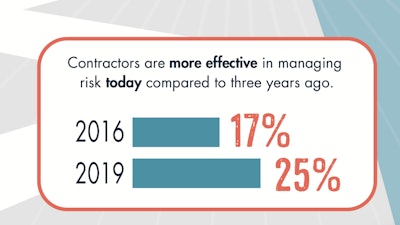
The engineering and construction (E&C) industry faced a very different risk environment three years ago, when AGC’s Surety Bonding and Risk Management Forum — in collaboration with FMI — conducted its first survey of that environment. E&C firms were having a difficult time adapting to a world where 35% of respondents thought their organizations were ineffective in managing risk. Since then, the industry has continued to evolve, and today it appears contractors are increasing their emphasis on risk as a strategic priority.
This year’s survey indicates that executives are more likely to take a proactive approach to risk management as opposed to viewing it as a defensive exercise. The most proactive firms are seeing a direct correlation between profitability and their success in identifying, assessing, managing and mitigating risk. Our research also shows that firms are using new tools and risk management strategies and leveraging technology in a more sophisticated way in order to adapt to the changing E&C landscape.
These trends are reflected in one study participant’s view: “There is a heightened risk consciousness and a heightened emphasis on risk assessment, management and training.”
As part of this year’s study, we also surveyed contractors’ perceptions around current and future risks and investigated how firms are preparing for a possible downturn. We also found that contractors are increasing their in-house design capabilities, in an effort to manage design risk more effectively. Contractors also shared their perceived benefits and challenges of developing such expertise.
Overall, this year’s study results indicate changes in the E&C risk environment over the last three years and provide important data points regarding future risk management trends. All information is based on more than 100 responses from best-in-class companies that are active in AGC’s Surety Bonding and Construction Risk Management Forum; the data was collected at the end of 2018.
Key findings are grouped into the following four main themes:
- Top Current and Future Risks
- Recession-Proofing Your Organization
- The Rise of In-House Design
- The Changing Risk Environment
For the third year in a row, a lack of qualified talent was the top risk for study participants, with the limited supply of skilled craft workers being the biggest challenge for 80% of respondents. The limited supply of field supervisors became the second most critical risk (44%) and reflects the ongoing demographic shift of baby boomers cycling out of the industry.
“What other industry turns over hundreds of millions of dollars of work to guys that they do not prepare adequately for the job? Only in construction,” said Mark Breslin, CEO of United Contractors. “More importantly, how much longer can we fool ourselves around the crucial conclusion that field leaders in this critical profit leadership position need new skills, tools and strategies?”
While rumblings about a recession on the horizon are starting to make company leaders a bit nervous, many are too busy keeping up with their current workload to start thinking about contingency planning. In fact, the constrained labor situation, coupled with material price increases, compressed project schedules, increased complexity and ongoing margin compression, is generating more risk for E&C firms today — and right when they find themselves in a market with more opportunities than capacity to perform the work. As we like to say, “Contractors don’t starve to death; they die from gluttony. They get too much work, too fast, with inadequate resources, and then they get into financial trouble and run out of cash.”
Read the full “2019 AGC/FMI Risk Management Survey."

















